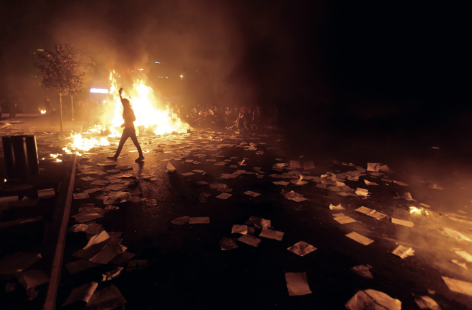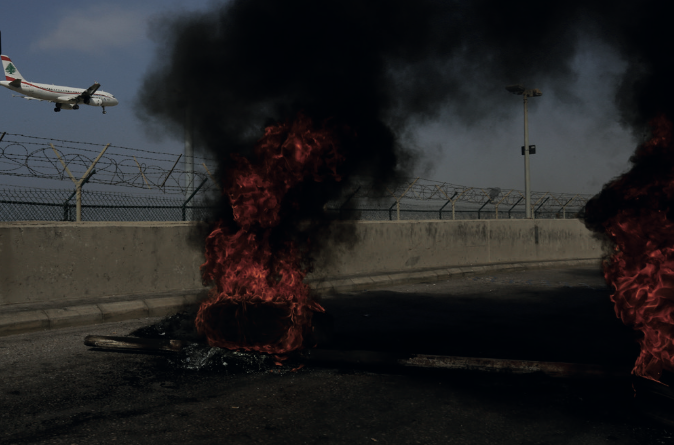Autumn is a Second Spring by Lokman Slim
With text by Lokman Slim
Messages began flooding photographer Marwan Tahtah’s phone in the late afternoon of Thursday, October 17, 2019. But like many Lebanese, he had experienced a lot in Lebanon and in his mind it was not particularly significant news that some youngsters had erected a roadblock here, or that others had started burning tires there. He therefore went about the rest of his day and headed home.
However, as the messages continued unabated into the night, his curiosity increased, and around midnight he decided to take his scooter and check out what was going on. Once in the vicinity of the Ring, the bridge that connects east and west Beirut, he caught sight of the unfolding scenes of protests, and it is at that moment that he took his first photograph of what came to be known as the “October 17 Revolution.”
Throughout the coming days and weeks, Marwan continued to follow the protests—mainly in Beirut and its surroundings—and captured his visions of events. As a photojournalist, some of the pictures he took were published in various media outlets, and as a photographer, additional images were shared from across his social media platforms.
For anyone closely monitoring the developments around the Revolution and the flow of photographs documenting its scenes, either as an activist or as a mere observer, it is not difficult to notice that Tahtah’s photographs differ from the many others in circulation. It is not that his pictures are the most graphic in terms of reporting, nor the most exhaustive in terms of documentation, nor the most sensational in terms of impact. However, they are notable because they are, in a way, contrary to these extremes. While conveying the tensions and anxieties of the “October 17” dynamics, his photographs do so in a graceful and sometimes distant way, both in the literal and figurative sense. One is inclined to imagine Tahtah not as an aggressive ambusher, rushing to fulfill his mission and return to safety, but as a serene sharpshooter, moving confidently through the fray and prescient of what will unfurl in front of him.
Grounded in its conviction that even pressing issues and rapidly developing events require thoughtful contemplation via mediated approaches, UMAM D&R sought to carve out a window for reflection on the dizzying events Lebanon has experienced in the past year, despite the on-going multi-layered environment of frustration. While brainstorming, Tahtah’s photographs naturally came to mind when thinking back on the events of last fall, and the initial version of this installation was conceived as a conventional photo exhibition. However, while selecting photographs to exhibit, the idea emerged of immersing the exhibition within replicas of the cement screens that have mushroomed in Beirut and other Lebanese cities post-October 17.
The photographs were thus overlaid on the 3D metal fixtures, remapping THE HANGAR, UMAM D&R’s exhibition space, into a series of literal nested windows of images, encouraging the viewers to enter confessional booth-like spaces to reflect within and on the scenes depicted. When it came to giving a title to this work, an Arabic weather lore came to mind, one which states that a summer can usually be found within the fall season, as a way of describing fall as a versatile and surprise-laden season.
While considering the Lebanese colloquial proverb “bayn tishreen wa tishreen sayf tani...,” literally meaning “between October and November, a second summer is to spring,” Camus’s famous observation, “autumn is a second spring when every leaf is a flower” came to mind. Thus, the title for this exhibit was born, albeit with the caveat that even when not every leaf is a flower, autumn is never devoid of a taste of summer.
The exhibition essay was written by Lokman Slim who co-founded of UMAM Documentation and Research, with his wife Monika Borgmann in 2005 at Haret Hreik, Beirut, Lebanon.





